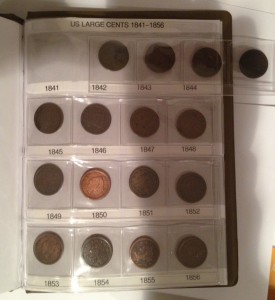Someone who may be interested in collecting coins may look at the options and think that they are too daunting. Guide books talk about series of dates, mint marks, and varieties. Type books talk about every representative type, even ones that are not affordable to the average collector. Then the folder and album publishers give their interpretation of what a type collection should look like. What the novice to average collector is left with is confusion.
Collecting coins, specifically United States coins does not have to be daunting. You can put together sets of your own design that represents any time or any period. What is great is that once you define your goals, you can have the fun in putting the set together and showing it off to friends and relatives. It is also something that you can develop your own story and include it in your own album.
This is why I decided to create the One Page Collection. My one-page is a 20 pocket archival safe page to hold 2×2 holders of some type—for this, I prefer the self-adhesive cardboard holders with mylar windows. These pages can be placed in three-ring binders that can be used to build any number of collections. It is as flexible as your collecting whims can be.An alternative to the pocket page are Gardmaster Coin Albums. Gardmaster is made by Collector’s Supply House of Paris, Ontario in Canada. Their albums are based on a slide system where the coins are placed into pockets of a strip and the strip is slid into the page keeping the coin in place without the need for an extra holder. The albums are a smaller size with a “Snappy” binder to remove, mix, and match pages. I discovered these albums while putting together a collection of Canadian coins. I then adapted a blank 16-pocket version to create a year set for large cents. You can do an Internet search to find a dealer who sells Gardmaster albums.
For these articles, I will stick with creating a collection using the 20-coin pocket page.
As a general rule, the coins in this collection must gradable at Fine or better and cost under $100. When I create a set of half-dollars and dollars, the limit will have to be raised because of the silver values and the rarity of earlier coins.
Since these are 20-coin sets, many die varieties are ignored to a certain degree. However, design and composition changes are always significant.
The first set I will create are the copper coins. Cents and half-cents were specified in the Coinage Act of 1792 that authorized the creation of the U.S. Mint. Under the new law, the half-cent and its larger cousin the one-cent coin was struck in pure copper from 1793 through 1857.
The first half-cent struck in 1793 weighed 6.74 grams and was 22 mm in diameter. Subsequently, the half-cent weighed 5.44 grams and its diameter varied between 22 mm and 22½ mm.
The 1793 large cent had two designs, the controversial chain reverse which was then changed to a wreath weighed 13.48 grams and varied between 26-28 mm in diameter. In the 19th century, the large cent weighed 10.89 grams and its diameter varied between 27 and 27½ mm.
Consistency in the size of both coins would not be achieved until the introduction of steam-based coining equipment starting in 1836.
Large copper coins were eliminated by the Coinage Act of 1857. Signed into law by President Franklin Pierce February 21, 1857, this act repealed the legal tender status for foreign coins in the United States. It required the Treasury to exchange foreign coins at a market rate set by Treasury. This act discontinued the half-cent and reduced the size of the one-cent coin from 27mm (large cent) to the modern size of 19.05mm (small cent) that is still being used today.
First small cent was the Flying Eagle cent designed by James B. Longacre. The eagle was based on a design Christian Gobrecht used on the reverse of the Seated Liberty dollars. The Flying Eagle cent was a short lived series because of its difficulty to strike properly.
After having problems with the Flying Eagle cent, Longacre designed the Indian Head cent—which is not the image of an Indian but a representation of Libery wearing an Indian-style headdress.
Rounding out our copper collection is the Lincoln cent. Introduced as part of President Theodore Roosevelt’s “pet crime,” the Victor D. Brenner designed coin has been around over 100 years with a periodic change in reverses including the new Shield reverse that began in 2010, 101 years after the coin’s debut with the wheat stalks on the reverse.
Looking at over 230 years of copper coinage there is a lot to choose from to try to make a representative set. The following is what I came up with:
Another idea is to use the Gardmaster album, buy two 16-coin pages, and expand your collection. As you look through the types, you may want to start with my “Manageable Lincoln Cent Collection” for an idea on expanding your Lincoln cent typeset. From there, you can adapt those concepts to the other cent series.
Showgard pocket pages image courtesy of Vidiforms/Showgard.




Thank you for this article. I had recently switched to ancient coins because there is so much variety and I was getting burned out on the tracking down dates and mint marks for coins that all look the same. The more history that is involved the better for me. Also, I didn’t know about the shotgun cents. That is awesome to know.